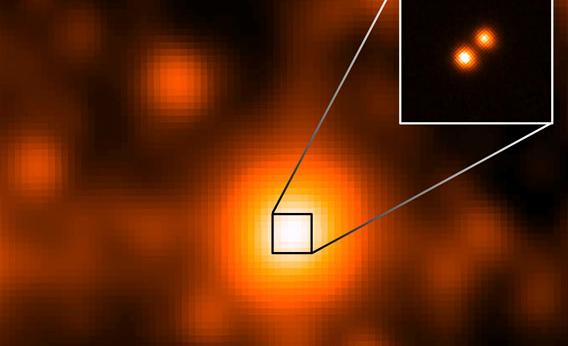Create a free profile to get unlimited access to exclusive videos, sweepstakes, and more!
Howdy, Neighbor! New Twin Stars Are Third Closest to the Sun

Astronomers have discovered some new neighbors: A pair of dim brown dwarf stars that are a mere 6.5 light years from Earth! Called WISE 1049-5319, they are the third-closest star system to us, after the Alpha Centauri triple star about 4.3 light years away, and Barnardâs star about six light years distant.
Youâd think weâd have a pretty good census of close stars, since theyâd be easy to spot. But thatâs not the case, because not all stars are bright. Brown dwarfs are extremely faintâthe first was only discovered in 1994âbecause unlike our Sun or other normal stars, they are not actively using nuclear fusion in their cores to generate heat and light. It takes a certain amount of mass to be able to squeeze atomic nuclei hard enough to get them to fuse, and brown dwarfs are just under that limit. They are far more massive than planets but still short of being âtrueâ stars. They range in mass from about 13 â 75 times that of Jupiter.
So one can be pretty close to us and still remain undetected. In this case, the stars were actually seen back in 1978, and twice again in more recent images. However, no one noticed them because they were so faint. Astronomer Kevin Luhman spotted them in images taken by the Wide-Field Infrared Survey Explorer, a NASA satellite that scanned the sky several times in infrared light, well outside what our eyes can see. Brown dwarfs donât give off much visible light, but theyâre warm, so they glow pretty well in the infrared.
WISE picked them up several times as it surveyed the sky. Luhman noticed the stars not because they were bright, but because they moved. All the stars you can see in the sky are moving, orbiting the center of the Milky Way galaxy, but they are so far away that motion is undetectable without telescopes. Even then, you usually have to wait years to detect it. But the closer a star is, the larger that motion seems; itâs like driving in a car and seeing nearby trees fly by while distant mountains appear nearly motionless.
Luhman noticed the starsâ motion in the WISE data and went back into the archives of other telescopes to find earlier observations. Over the past 30 years or so, the movement of the stars is obvious.
Whatâs not obvious is that there are two stars, not one. They orbit each other so closely they look like a single star. It was only when Luhman observed them with the huge Gemini telescope that it became apparent they were actually a binary star. He used Gemini to obtain spectra of the starsâbreaking their light up into hundreds of individual wavelengths, like a rainbow with hundreds of colorsâin order to determine their temperature, mass, and chemical composition. The spectra revealed these were, in fact, brown dwarfs far smaller than the Sun.
This is pretty exciting news for several reasons. For one, itâs always nice (and fun) to discover something surprising, especially when itâs so close. The distance itself is also interesting; if these two stars have planets theyâll be a lot easier to detect than usual because they are so close to us. Plus, the faintness of the stars will make any potential planets easier to see.
Also, for years Iâve wondered aloud if there are any stars closer than Alpha Centauri to us. Recent surveys of the sky have made that seem unlikely, but now I wonder. Those same surveys missed WISE 1049-5319. Could there be an even fainter star or stars closer to us? Iâll admit itâs unlikely, but not impossible.
And Alpha Centauri has a planet, discovered only in late 2012. Weâve seen planets around brown dwarfs before. Theyâre very unlikely to be Earth-like (brown dwarfs donât give off enough heat to keep a planet warm enough for liquid water unless the planet orbits very close in), but what weâve been finding, over and again, is that the Universe is capable of surprising us. Itâs a big place, and amazingly weâre still finding new things in our own cosmic back yard. Iâll add that Barnardâs star, a faint red dwarf, was discovered in 1916. WISE 1049-5319 is the closest star system found in nearly a century, and it was sitting right there the whole time.
So, howdy neighbor! I hope you donât mind if we lean over the fence and get to know you better. Itâs not often we get new folks around here, and weâre a curious bunch.


























